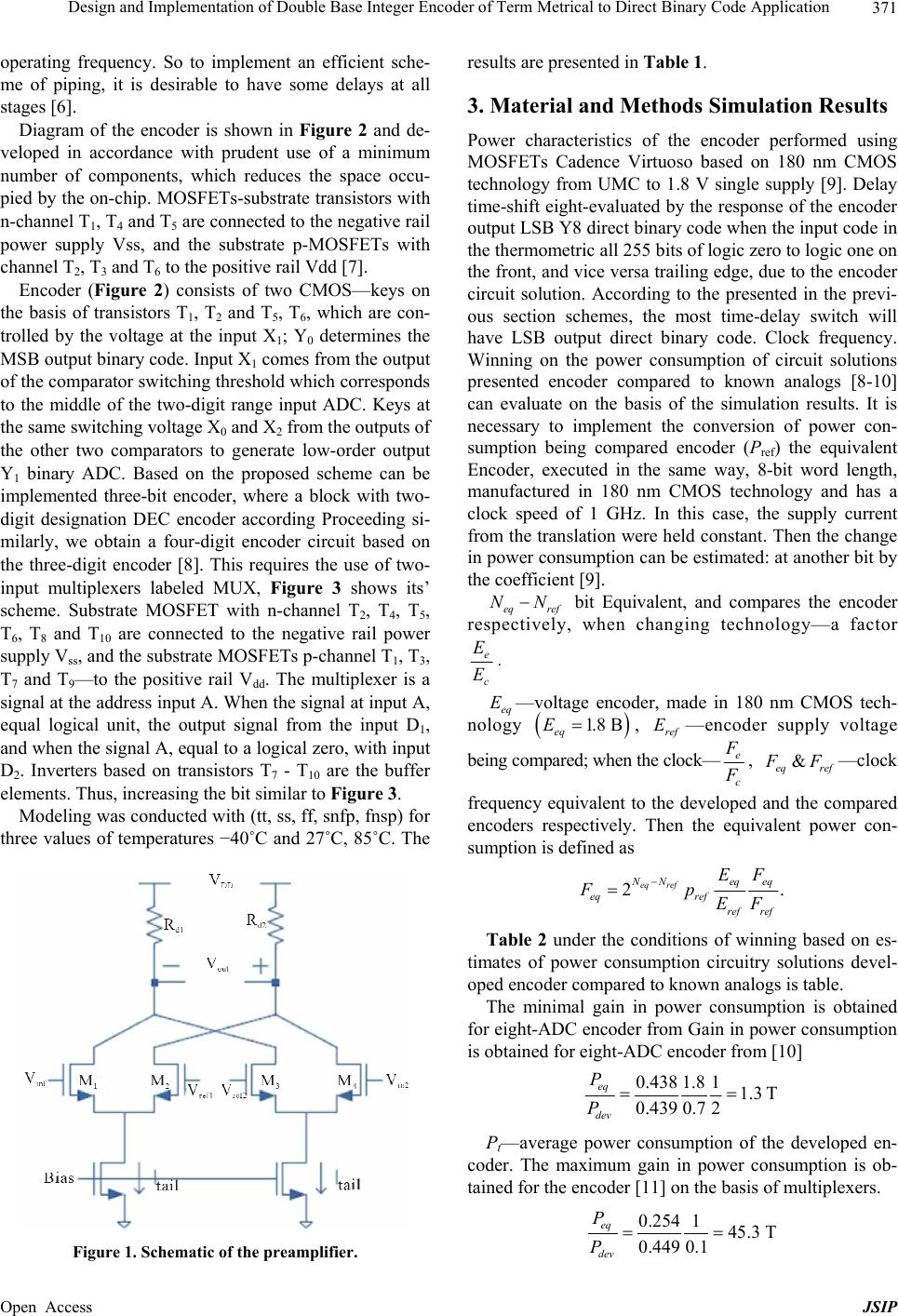
Design and Implementation of Double Base Integer Encoder of Term Metrical to Direct Binary Code Application 371
operating frequency. So to implement an efficient sche-
me of piping, it is desirable to have some delays at all
stages [6].
Diagram of the encoder is shown in Figure 2 and de-
veloped in accordance with prudent use of a minimum
number of components, which reduces the space occu-
pied by the on-chip. MOSFETs-substrate transistors with
n-channel T1, T4 and T5 are connected to the negative rail
power supply Vss, and the substrate p-MOSFETs with
channel T2, T3 and T6 to the positive rail Vdd [7].
Encoder (Figure 2) consists of two CMOS—keys on
the basis of transistors T1, T2 and T5, T6, which are con-
trolled by the voltage at the input X1; Y0 determines the
MSB output binary code. Input X1 comes from the output
of the comparator switching threshold which corresponds
to the middle of the two-digit range input ADC. Keys at
the same switching voltage X0 and X2 from the outputs of
the other two comparators to generate low-order output
Y1 binary ADC. Based on the proposed scheme can be
implemented three-bit encoder, where a block with two-
digit designation DEC encoder according Proceeding si-
milarly, we obtain a four-digit encoder circuit based on
the three-digit encoder [8]. This requires the use of two-
input multiplexers labeled MUX, Figure 3 shows its’
scheme. Substrate MOSFET with n-channel T2, T4, T5,
T6, T8 and T10 are connected to the negative rail power
supply Vss, and the substrate MOSFETs p-channel T1, T3,
T7 and T9—to the positive rail Vdd. The multiplexer is a
signal at the address input A. When the signal at input A,
equal logical unit, the output signal from the input D1,
and when the signal A, equal to a logical zero, with input
D2. Inverters based on transistors T7 - T10 are the buffer
elements. Thus, increasing the bit similar to Figure 3.
Modeling was conducted with (tt, ss, ff, snfp, fnsp) for
three values of temperatures −40˚C and 27˚C, 85˚C. The
Figure 1. Schematic of the preamplifier.
results are presented in Table 1.
3. Material and Methods Simulation Results
Power characteristics of the encoder performed using
MOSFETs Cadence Virtuoso based on 180 nm CMOS
technology from UMC to 1.8 V single supply [9]. Delay
time-shift eight-evaluated by the response of the encoder
output LSB Y8 direct binary code when the input code in
the thermometric all 255 bits of logic zero to logic one on
the front, and vice versa trailing edge, due to the encoder
circuit solution. According to the presented in the previ-
ous section schemes, the most time-delay switch will
have LSB output direct binary code. Clock frequency.
Winning on the power consumption of circuit solutions
presented encoder compared to known analogs [8-10]
can evaluate on the basis of the simulation results. It is
necessary to implement the conversion of power con-
sumption being compared encoder (Pref) the equivalent
Encoder, executed in the same way, 8-bit word length,
manufactured in 180 nm CMOS technology and has a
clock speed of 1 GHz. In this case, the supply current
from the translation were held constant. Then the change
in power consumption can be estimated: at another bit by
the coefficient [9].
eqref bit Equivalent, and compares the encoder
respectively, when changing technology—a factor
NN
e
c
E
E.
eq —voltage encoder, made in 180 nm CMOS tech-
nology
E
1. 8 В
eq
E, —encoder supply voltage
ref
E
being compared; when the clock—e
c
, &
eq ref
F—clock
frequency equivalent to the developed and the compared
encoders respectively. Then the equivalent power con-
sumption is defined as
2.
eq ref
NN eq eq
eqref ref ref
EF
Fp
EF
Table 2 under the conditions of winning based on es-
timates of power consumption circuitry solutions devel-
oped encoder compared to known analogs is table.
The minimal gain in power consumption is obtained
for eight-ADC encoder from Gain in power consumption
is obtained for eight-ADC encoder from [10]
0.438 1.811.3 T
0.439 0.7 2
eq
dev
P
P
Pt—average power consumption of the developed en-
coder. The maximum gain in power consumption is ob-
tained for the encoder [11] on the basis of multiplexers.
0.254 145.3 T
0.449 0.1
eq
dev
P
P
Open Access JSIP